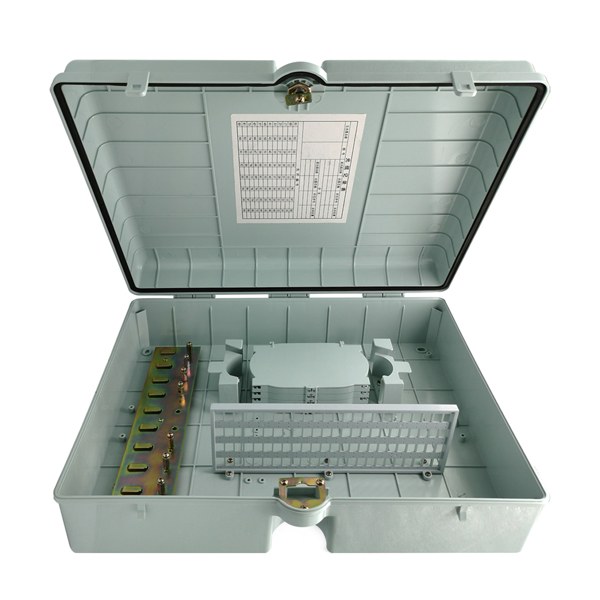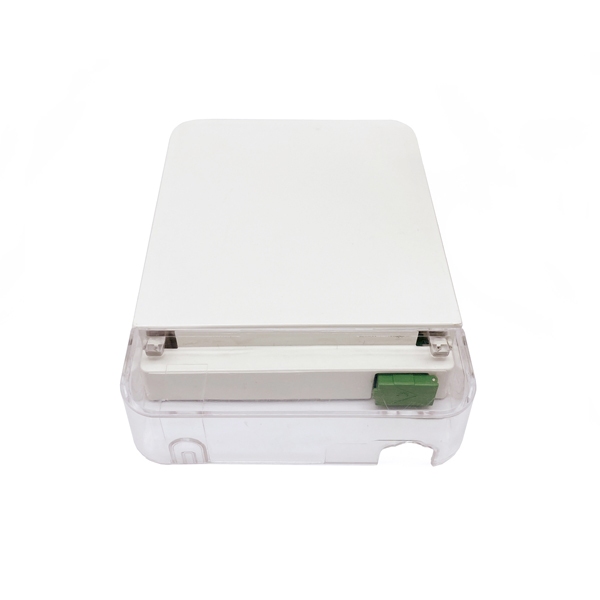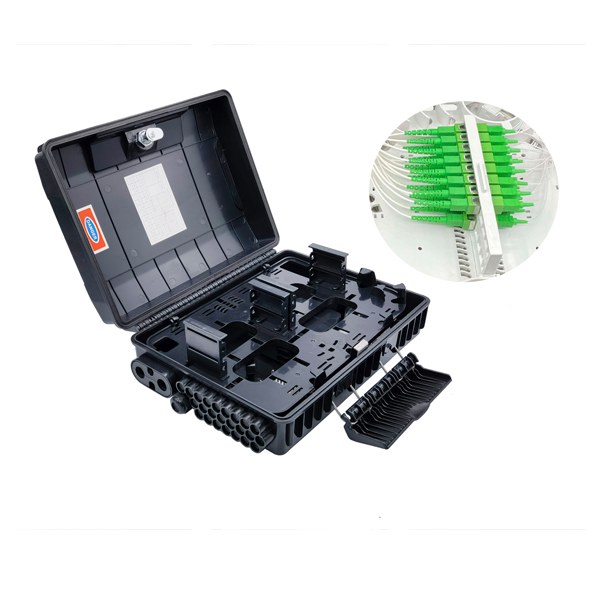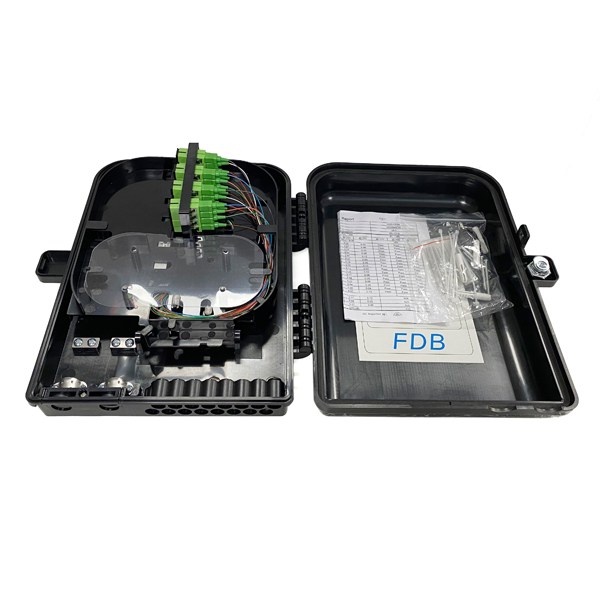Fiber broadband is to convert the data from electrical signals to optical signals with optical modems at both ends. Fiber is the most ideal transmission medium among various transmission media in broadband networks. Its characteristics are large transmission capacity, good transmission quality, low loss, long relay distance, etc. And the fiber access can ensure high bandwidth about 10Mbps, 100Mbps, and 1000Mbps till the backbone node.
At present, there is 2 broadband access methods are widely used: FTTB and FTTH, and expose the difference from access method, equipment configuration, performance and maintenance, etc.
Access method difference
FTTH is bring the fiber to the user’s home, and install an optical modem (ONT) at home to complete the optical-electrical conversion and realize end-to-end all-optical transmission, so you can see the small fiber splitter box and optical roseta on wall.
FTTB is only laid to the building equipment room (such as the weak current shaft in the corridor), and connected to the user’s home through copper cable (network cable or telephone cable). In the floors or basement room, you can find the big fiber optic distribution box, optical fiber cabinet as below:

Note: FTTB requires the deployment of ONU in the corridor to centrally convert signals, and the user end relies on ordinary routers or modems for access.
Device Configuration Comparison
| Scenario | Equipment in the building | Client equipment | Bandwidth allocation method |
| FTTH | Passive optical splitter (no power required) | Independent optical modem (ONT) for each household | Exclusive bandwidth |
| FTTB | ONU (power required) | Ordinary router/modem | Shared bandwidth |
Performance and experience differences
FTTH supports Gigabit bandwidth and above (such as 50G-PON technology), which can meet high-demand scenarios such as 8K video and VR, while FTTB is limited by copper cable transmission, and the bandwidth is usually less than 300Mbps, which is prone to congestion during peak hours.
FTTH has strong anti-interference throughout the optical fiber, with a delay of less than 10ms and greater stability, while FTTB copper cables are susceptible to electromagnetic interference and have a higher failure rate.
FTTH directly supports future 10G upgrades (such as FTTR). FTTB uses network cables at the home end, but the bandwidth of copper cables is limited. If the bandwidth needs to be increased, rewiring is required. FTTB requires sharing the corridor switch with neighbors, which means that the network speed stability is poor during peak hours and the user experience is not as good as fiber-to-the-home (FTTH) with exclusive fiber access to the home.
Maintenance cost and complexity
The key points of FTTH maintenance are anti-bending of the fiber optic cable entering the home, optical attenuation detection of the optical splitter, and high requirements for the welding process.
The ONU in the FTTB building needs power supply, which is prone to failure. At the same time, the aging of the copper cable requires maintenance, and line interference needs to be frequently handled.
Cost advantage
Taking all factors into consideration, the initial deployment cost of FTTH is more than 30% higher (indoor fiber optic cabling is required), but the long-term operation and maintenance cost is lower than FTTB.
| Item | FTTH | FTTB |
| Fiber optic terminal | User’s home | Corridor equipment room |
| Transmission medium | Throughout fiber all the line | In-building copper cable + trunk fiber |
| Bandwidth experience | Exclusive Gigabit, low latency | Shared 100M, lag during peak hours |
| Applicable scenarios | New residential buildings, high-end users | Old residential area renovation, high-density rental housing |
| Technology evolution | Supports next-generation technologies such as FTTR, 50G-PON | Upgrade restrictions, copper cable replacement required |
In short, FTTH is the ultimate fiber solution, with the best performance but high deployment cost; FTTB is a compromise, suitable for fast coverage of densely populated areas, but with natural bottlenecks in bandwidth and stability.
FAQ
Where can use FTTB?
FTTH is suitable for residential apartments, especially those old communities where optical fiber has been laid but not directly to households. It is also suitable for office buildings, especially large and medium-sized enterprises and commercial users or for projects that require network transformation. It can use the existing copper cable resources inside the building to reduce the difficulty and cost of construction, and is particularly suitable for network upgrades in old communities.
Which is more stable, FTTH or FTTB?
FTTH (fiber to the home) is more stable than FTTB (fiber to the building). FTTH is to install the optical network unit (ONU) directly in the user’s home, and the optical fiber goes directly to the user, with minimal signal loss and low latency, which is suitable for application scenarios with high bandwidth requirements, such as high-definition video conferencing, large-scale cloud games, and smart home devices online at the same time. In contrast, the optical fiber of FTTB only reaches the corridor, and the last 100 meters depends on other lines. The signal attenuation is large and the stability is poor. It is suitable for ordinary families with low bandwidth requirements.
How much of FTTH bandwidth capacity?
FTTH has a very strong bandwidth capacity, which can provide bandwidth of Gigabit or above. In actual tests, home users can stably reach 500M or even 1000M speeds. Compared with traditional copper cables (such as ADSL/VDSL), FTTH is not affected by distance and interference, and can maintain high-speed transmission over longer distances with more stable speeds.
What is the disadvantage of FTTB?
The main disadvantages of FTTB include bandwidth sharing, large fluctuations in network speed, easy congestion during peak hours, high installation and maintenance costs, and difficulty in power supply.
What is the future of FTTB?
FTTB refers to the laying of optical fiber throughout the building (such as residential buildings and commercial buildings), and then distributed to each user through other technologies (such as network cables). This technology has been applied in many places, and with the advancement of technology and the increase in demand, its future development prospects are promising.
The combination of FTTB and FTTR, which is currently vigorously promoted by operators, will further promote the comprehensive upgrade of home networks. FTTR is a new coverage mode for home networks in the gigabit era. It lays optical fiber to every room to ensure that every room can enjoy gigabit optical fiber network speed and achieve full-house Wi-Fi6 gigabit coverage without blind spots. This technology not only improves the transmission rate and coverage range, but also supports more terminal device connections, solving the problems of uneven coverage and rate limitation of traditional networks. After combining FTTB with FTTR, it can provide stronger wall penetration ability and lower signal attenuation, which is suitable for spacious residences such as large flats and villas.
Is the installation and maintenance cost of FTTB high?
The installation and maintenance cost of FTTB (fiber to the building) is relatively high. Because shared switch equipment may require more maintenance work, and once a problem occurs, it may affect the network use of multiple households. In contrast, the installation and maintenance cost of FTTH is lower. FTTH is an exclusive fiber-to-the-home service, and there is no need to share equipment with neighbors, so the network speed is more stable during peak hours and the user experience is better. In addition, FTTH uses a passive optical network, which has a lower opening rate, failure rate and maintenance rate, thereby greatly reducing the overall cost.






